| Pages:
1
2
3
4 |
metalresearcher
National Hazard
   
Posts: 731
Registered: 7-9-2010
Member Is Offline
Mood: Reactive
|
|
What did actually explode in Tianjin ?
A big explosion in Tianjin in a chemicals storage area happened with sad results.
I think this will greatly impact on safety regulations in Chinese production and storage facilities.
But as a chemistry hobbyist (but not the least important, the safety authorities) I want to know WHAT actually exploded ?
Wikipedia reports tons of CaC2, KNO3, NaNO3 and NaCN were stored.
None of these chemicals do explode from themselves.
So there must be lots of CaC2 got in contact with water and the resulting C2H2 buildup with air oxygen indeed can result in such an explosion.
Then the nitrates can do their 'work' when spread around in a hot and fiery environment.
But that is my theory. News media do not mention anything about the nature of the explosion.
|
|
|
j_sum1
Administrator
       
Posts: 6218
Registered: 4-10-2014
Location: Unmoved
Member Is Offline
Mood: Organised
|
|
I don't know wht it was but it looked like this: https://www.youtube.com/embed/nhsOXdomPNU
And if there was NaCN there then the spread might have been significant.
I would love further details on what exactly exploded. I am going to guess that a significant amount of KNO3 was in the mix.
|
|
|
j_sum1
Administrator
       
Posts: 6218
Registered: 4-10-2014
Location: Unmoved
Member Is Offline
Mood: Organised
|
|
Difficult to pin down an actual list of what was stored on the site and what might have contributed to the explosion. (Unsurprising.)
From here I found a few detais that I had not found elsewhere.
| Quote: | Reuters reported that, according to a 2014 government assessment, the Ruihai facility was designed to store chemicals including butanone, an explosive industrial solvent, sodium cyanide and compressed
natural gas.
The company also reportedly handles toluene diisocyanate, which is used in the production of flexible polyurethane
foams.
Officials have confirmed that calcium carbide, potassium nitrate, ammonium nitrate and
sodium nitrate were at the warehouse.
Police have also confirmed that sodium cyanide was present near the site |
Some reports suggest that water fro firefighters may have been a contributing factor -- certainly a problem if calcium carbide got wet.
From here.
| Quote: | | Tianjin work safety official Gao Huaiyou listed a host of possible substances at the briefing, adding that the firm's recent large exports had
included sodium bisulfide, magnesium, sodium, potassium nitrate, ammonium nitrate, and sodium cyanide, among others.
|
[Edited on 16-8-2015 by j_sum1]
|
|
|
softbeard
Hazard to Self
 
Posts: 69
Registered: 23-7-2013
Member Is Offline
Mood: moody
|
|
Quote: Originally posted by j_sum1  | Difficult to pin down an actual list of what was stored on the site and what might have contributed to the explosion. (Unsurprising.)
From here I found a few detais that I had not found elsewhere.
| Quote: | Reuters reported that, according to a 2014 government assessment, the Ruihai facility was designed to store chemicals including butanone, an explosive industrial solvent, sodium cyanide and compressed
natural gas.
The company also reportedly handles toluene diisocyanate, which is used in the production of flexible polyurethane
foams.
Officials have confirmed that calcium carbide, potassium nitrate, ammonium nitrate and
sodium nitrate were at the warehouse.
Police have also confirmed that sodium cyanide was present near the site |
Some reports suggest that water fro firefighters may have been a contributing factor -- certainly a problem if calcium carbide got wet.
|
My 2 cents:
From the videos of the explosion I've seen, I'm willing to make a couple of guesses;
1. Initially there was a some kind of hydrocarbon or flammable solvent fire which burned relatively quietly.
2. There is only one common chemical which is produced and stored in large enough quantities (ie. tons) that would cause the detonations that
occurred; ammonium nitrate.
The hydrocarbon/solvent fire heated the ammonium nitrate until it detonated (twice). Possibly a small part of the ammonium nitrate got contaminated
with something that acted as a fuel/sensitizer and set off the rest of it.
3. The fireworks-like burning streamers seen coming down from thousands of feet in the air are burning sodium metal.
The points above are, of course, guesses. Still, these were the first things I thought of when I saw videos of the explosions. This was before I had
seen any lists of chemicals possibly stored on the site.
Calcium carbide might cause a fireball of burning acetylene if accidentally doused with water. It would not cause a detonation and shock wave that
blew out windows for miles around.
|
|
|
Bert
Super Administrator
        
Posts: 2821
Registered: 12-3-2004
Member Is Offline
Mood: " I think we are all going to die. I think that love is an illusion. We are flawed, my darling".
|
|
No chemistry here, just a lot of unofficial pictures by a Chines journo who snuck past the police lines.
http://chinadigitaltimes.net/2015/08/he-xiaoxin-how-far-can-...

[Edited on 16-8-2015 by Bert]
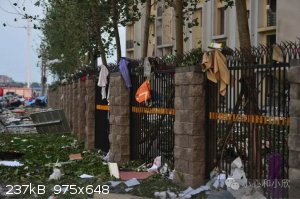 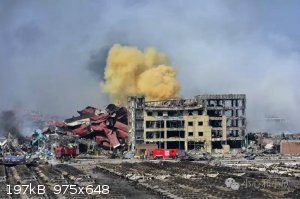 
Rapopart’s Rules for critical commentary:
1. Attempt to re-express your target’s position so clearly, vividly and fairly that your target says: “Thanks, I wish I’d thought of putting it
that way.”
2. List any points of agreement (especially if they are not matters of general or widespread agreement).
3. Mention anything you have learned from your target.
4. Only then are you permitted to say so much as a word of rebuttal or criticism.
Anatol Rapoport was a Russian-born American mathematical psychologist (1911-2007).
|
|
|
softbeard
Hazard to Self
 
Posts: 69
Registered: 23-7-2013
Member Is Offline
Mood: moody
|
|
Hmm... I wonder what that bright yellow-orange smoke is.
The crumpled steel skin of that SUV in the last photo is telling. It's the result of strong shock waves, indicative of a high-order detonation. I
doubt exploding acetylene-air could cause this.
|
|
|
metalresearcher
National Hazard
   
Posts: 731
Registered: 7-9-2010
Member Is Offline
Mood: Reactive
|
|
Quote: Originally posted by softbeard  |
3. The fireworks-like burning streamers seen coming down from thousands of feet in the air are burning sodium metal.
|
Where does that come from ? Unless Na metal was also stored at the warehouse.
Judging from a screenshot of the (poor quality) video the color of the streamers is white. When it were Na metal they would be bright yellow. No of
the available chemicals was able to release Na metal in these explosions.
But, indeed NH4NO3 is a viable option. This can detonate rather easily.
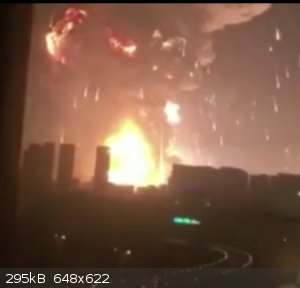
[Edited on 2015-8-16 by metalresearcher]
|
|
|
softbeard
Hazard to Self
 
Posts: 69
Registered: 23-7-2013
Member Is Offline
Mood: moody
|
|
from j_sum1's post:
"...included sodium bisulfide, magnesium, sodium, potassium nitrate,
ammonium nitrate, and sodium cyanide, among others"
Burning sodium was the 1st thing I thought of even before I saw it as listed possibly being stored on-site. You can't tell the exact color from the
footage. Looks yellow to me, BTW.
"This (NH4NO3) can detonate rather easily."
Actually, under normal circumstances, no it can't. Normally, unless sensitized, NH4NO3 can only be detonated by a very strong
shock wave. However, as dozens of accidental explosions in the last 2 centuries have demonstrated, when large quantities of
NH4NO3 (several tons or more) are involved in large fires, detonations do occur (last major one IIRC was a Texas fertilizer
plant not too long ago).
[Edited on 16-8-2015 by softbeard]
|
|
|
hissingnoise
International Hazard
    
Posts: 3940
Registered: 26-12-2002
Member Is Offline
Mood: Pulverulescent!
|
|
| Quote: | | I doubt exploding acetylene-air could cause this. |
Well, air/ethyne mixtures are indeed powerful explosives as seen here!
|
|
|
softbeard
Hazard to Self
 
Posts: 69
Registered: 23-7-2013
Member Is Offline
Mood: moody
|
|
Acetylene/air may be a powerful explosive, but you would need at vey large volume of a 'just-right' mixture to cause the effects witnessed. Very
unlikely scenario. Much more likely any acetlylene produced in the fire just burns quietly. Everything points to a solid-phase explosive rather than a
fuel/air mixture as the culprit, in my opinion.
|
|
|
S.C. Wack
bibliomaster
    
Posts: 2419
Registered: 7-5-2004
Location: Cornworld, Central USA
Member Is Offline
Mood: Enhanced
|
|
WTF
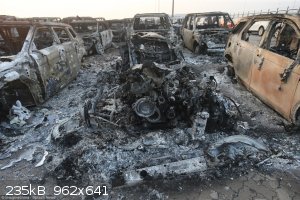
|
|
|
softbeard
Hazard to Self
 
Posts: 69
Registered: 23-7-2013
Member Is Offline
Mood: moody
|
|
The steel has melted from the intense heat of the fire.
|
|
|
phlogiston
International Hazard
    
Posts: 1375
Registered: 26-4-2008
Location: Neon Thorium Erbium Lanthanum Neodymium Sulphur
Member Is Offline
Mood: pyrophoric
|
|
Then why just that car, and not the surrounding ones?
-----
"If a rocket goes up, who cares where it comes down, that's not my concern said Wernher von Braun" - Tom Lehrer |
|
|
softbeard
Hazard to Self
 
Posts: 69
Registered: 23-7-2013
Member Is Offline
Mood: moody
|
|
Uh, either,
1. Something focused a bit more heat onto the space it occupied.
2. It was a really shitty car. 
Seriously, you can imagine dozens of scenarios. Maybe some burning 2-butanone (MEK), or whatever liquid was burning, pooled under it because the
ground isn't perfectly flat. You can expect a lot of these apparent anomalies in a disaster zone like this.
|
|
|
froot
Hazard to Others
  
Posts: 347
Registered: 23-10-2003
Location: South Africa
Member Is Offline
Mood: refluxed
|
|
If there was Na in the mix then it's also possible the hydrogen generated from contact with water contributed to the massive detonation. Even if a
relatively small amount of acetylene or hydrogen mixed with air and detonated that could've been enough to set the NH4NO3 off.
Those shockwaves are scary!
Edit:
Found this: http://www.news24.com/World/News/A-possible-list-of-the-haza...
[Edited on 16-8-2015 by froot]
We salute the improvement of the human genome by honoring those who remove themselves from it.
Of necessity, this honor is generally bestowed posthumously. - www.darwinawards.com |
|
|
Magpie
lab constructor
    
Posts: 5939
Registered: 1-11-2003
Location: USA
Member Is Offline
Mood: Chemistry: the subtle science.
|
|
from j_sum1's post:
"...included sodium bisulfide, magnesium, sodium, potassium nitrate,
ammonium nitrate, and sodium cyanide, among others"
When I saw the white light I also thought burning metal. Perhaps they were storing powdered magnesium?
The single most important condition for a successful synthesis is good mixing - Nicodem
|
|
|
softbeard
Hazard to Self
 
Posts: 69
Registered: 23-7-2013
Member Is Offline
Mood: moody
|
|
Looks like iodine or iodine compounds were on-site
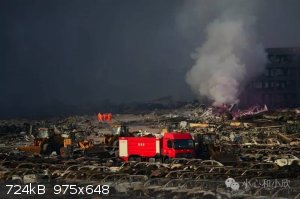
The fire was hot enough to melt steel
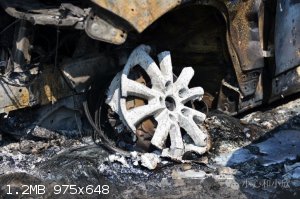 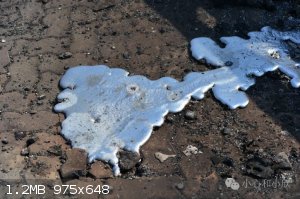
[Edited on 16-8-2015 by softbeard]
|
|
|
Gargamel
Hazard to Others
  
Posts: 166
Registered: 9-3-2013
Member Is Offline
Mood: No Mood
|
|
Looks like a car with aluminium body 
The censorship is really a shame. Why don't these people protest much more against it?
Typically underdeveloped country...
|
|
|
softbeard
Hazard to Self
 
Posts: 69
Registered: 23-7-2013
Member Is Offline
Mood: moody
|
|
I agree. It's very possible the melted metal in the pictures is Al, not steel. I saw some what looked like melted engine blocks, but it could all be
Al.
|
|
|
Bert
Super Administrator
        
Posts: 2821
Registered: 12-3-2004
Member Is Offline
Mood: " I think we are all going to die. I think that love is an illusion. We are flawed, my darling".
|
|
I have blown up/burned up several cars for movie or video shoots.
There are various parts made of such low melting materials as Al, Al alloys, Zinc and other low temp casting alloys- Similar molten puddles are quite
commonly found under the burned out vehicle after using a liquid accelerant and low explosives for this type of effect.
When the STEEL melts or burns completely away... It was clearly a whole lot hotter than a fire aspirated by mild convection is likely to get.
Fire storm conditions with high speed winds being sucked into the burning area can indeed soften or completely melt steel structures, I wonder if the
fire reached these conditions?
Rapopart’s Rules for critical commentary:
1. Attempt to re-express your target’s position so clearly, vividly and fairly that your target says: “Thanks, I wish I’d thought of putting it
that way.”
2. List any points of agreement (especially if they are not matters of general or widespread agreement).
3. Mention anything you have learned from your target.
4. Only then are you permitted to say so much as a word of rebuttal or criticism.
Anatol Rapoport was a Russian-born American mathematical psychologist (1911-2007).
|
|
|
froot
Hazard to Others
  
Posts: 347
Registered: 23-10-2003
Location: South Africa
Member Is Offline
Mood: refluxed
|
|
Notice the painted parking lot line at the bottom right. I should paint my house with that!
We salute the improvement of the human genome by honoring those who remove themselves from it.
Of necessity, this honor is generally bestowed posthumously. - www.darwinawards.com |
|
|
metalresearcher
National Hazard
   
Posts: 731
Registered: 7-9-2010
Member Is Offline
Mood: Reactive
|
|
Modern car engine and wheel parts are sometimes made of Al alloy or even Mg alloy. When that latter starts burning is will result in a very hot fire.
What about thermite (common stuff for railway welding) stored in the warehouse ? This is usually sold ready for use in bags which should be emptied in
a crucible over a railway seam and then ignited by an oxyacetylene flame or a sparkler.
So a high temperature source like burning Mg alloy or KNO3 / NH4NO3 with a combustible can set off a thermite bag and all the adjacent bags, resulting
in a very hot fire (2500 C) which can easily ignite other stuff and result in such an explosion.
|
|
|
Gargamel
Hazard to Others
  
Posts: 166
Registered: 9-3-2013
Member Is Offline
Mood: No Mood
|
|
The crater reminds one of the Oppau blast in 1921:
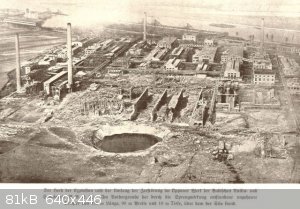
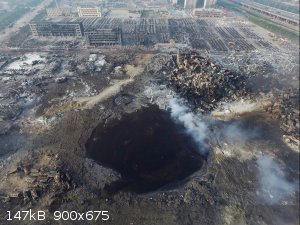
Crazy thing is, without the internet and modern technology the Chinese Gestapo would have held back the whole information.
And if it was up to them, we would never see a single picture.
[Edited on 17-8-2015 by Gargamel]
[Edited on 17-8-2015 by Gargamel]
[Edited on 17-8-2015 by Gargamel]
[Edited on 17-8-2015 by Gargamel]
|
|
|
careysub
International Hazard
    
Posts: 1339
Registered: 4-8-2014
Location: Coastal Sage Scrub Biome
Member Is Offline
Mood: Lowest quantum state
|
|
Indeed. This points pretty clearly to a condensed matter phase explosion.
[Edited on 18-8-2015 by careysub]
|
|
|
PHILOU Zrealone
International Hazard
    
Posts: 2893
Registered: 20-5-2002
Location: Brussel
Member Is Offline
Mood: Bis-diazo-dinitro-hydroquinonic
|
|
Acetylen and cyanhydric acid both are endothermic compounds; as such they can detonate back to their elements generating heat...this can happen when
shocked (pressurized), when heated or when explosive polymerization starts.
A stoechiometric mix of Acetylen/air in a 100L trash bag can blow a "maconery brick wall" down if put in contact aside and fired and that is just a
few dozens of grams!
As a bonus those compounds burn with a lot of heat (flame temperature of acetylen is 3000-3100°C and that of cyanhydric acid is 3300-3500°C). The
last compound is also quite toxic...and it seems it causes troubles now to people trying to clean the blast area.
Last but not least owing to their inerant explosivity on their own; those two compounds display a very large limit of explosion with air.
The amount of chemicals stored doesn't allow one to be sure of what exploded...
-NaCN is detonable with NaNO2 or NaNO3 for example.
-NH4NO3 is detonable or sensitized by a very long list of compounds .
-Magnesium and oxydisers may detonated
-Toluen diisocyanate may polymerise explosively under certain circumstances
-butanone may polymerise explosively under certain circumstances
By watching at the explosion video...one see the bright yellow-orange characteristic of divided carbon fuel (like the carbon dust/sooth formed during
explosion of acetylen)...NH4NO3 would detonate much colourless/ with white fumes.
The falling flames are probably burning barrels of chemical products (flying bombs)...if such a barrel falls on a car, it will burn it very deeply and
leave the rest of the cars almost unaffected.
If you are far from such a blast...the radiation of the heat could burn your car even if apparently at a safe distance of several hunderd meters!
In Belgium we had a gas pipe exploded (at Ghislenghien in an industrial area) with a flame of about 100 m...the radiation of this caused driving cars
on the highway a few hunders meters away to burn or to melt)...the heat could be felt two kilometers away! Here the blast is much bigger and the gas
involved probably more energetic so the radiation area should be even more than a few kilometers arround!
PH Z (PHILOU Zrealone)
"Physic is all what never works; Chemistry is all what stinks and explodes!"-"Life that deadly disease, sexually transmitted."(W.Allen)
|
|
|
| Pages:
1
2
3
4 |